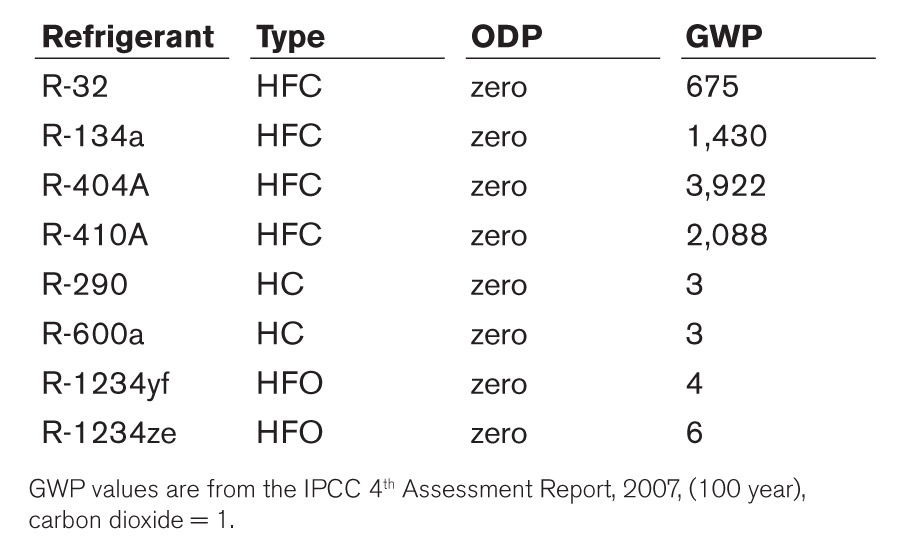Hydrofluorocarbon (HFC)-134a replaced chlorofluorocarbon (CFC)-12. Now, 134a is on its way out, too.
The July 2, 2015, ruling from the U.S. Environmental Protection Agency (EPA) set forth the time frames for the phasedown of certain HFC refrigerants in specific applications. Since then, there has been no if, ands, or buts about it: The HVACR industry will be fading away from heavy use of HFC refrigerants that have unacceptable global-warming potential (GWP) values. Table 1 lists some refrigerants and their GWP values for comparison purposes.
Many refrigerants have been delisted in certain applications under the EPA’s recent rule, “Protection of Stratospheric Ozone: Change of Listing Status for Certain Substitutes” under the Significant New Alternatives Policy (SNAP) Program. For example, for new and retrofit retail food refrigeration, including stand-alone equipment, condensing units, direct and indirect supermarket systems, and new and retrofit vending machines, the popular refrigerant blends HFC-507A and HFC-404A are listed as unacceptable. R-134a has been determined as unacceptable for new stand-alone retail food refrigeration and new vending machines. The rules will be phased in over various time frames for the various equipment, but all by Jan. 1, 2020. R-134a also is considered unacceptable in motor vehicle air conditioning in newly manufactured light-duty vehicles starting with model year 2021.
This means the industry will transition to low-GWP refrigerants, whether they be HFCs, hydrofluoroolefins (HFOs), hydrocarbons (HCs), or some other natural refrigerant. At the same time, this industry will strive to develop other alternative refrigerants that are efficient, affordable, and environmentally safe. There also are code and standard task forces within the industry that have been addressing barriers to adaption of mildly flammable, low-GWP refrigerants, such as accelerating the implementation of fire and building codes for such refrigerants.
COMPARING HFC-134A AND CFC-12
Many of us remember working comfortably with R-12, R-22, and R-502, and then transitioning over to and becoming comfortable with R-134a, R-410A, and R-404A. We must now change again and get used to handling lower-GWP alternate refrigerants. As the applications become limited for R-134a, let’s take a closer look at this refrigerant.
In years gone by, HFC-134a used to be the alternative refrigerant of choice to replace R-12 (CFC-12) in many medium- and high-temperature stationary refrigeration and air conditioning applications. It also replaced CFC-12 in automotive air conditioning applications. However, HFC-134a is not and was never a direct drop-in replacement for CFC-12. Retrofit guidelines always had to be followed carefully when converting a system to HFC-134a.
HFC-134a is a very safe refrigerant and has a safety classification of A1. This means it is not flammable and is very low in toxicity. Table 2 addresses toxicity and flammability of refrigerants. Notice that a classification of A1 is the safest, whereas a classification of B3 would be the most toxic and flammable.
HFC-134a is not a refrigerant blend. It is considered a pure compound and has only one molecule present, consisting of carbon (C), fluorine (F), and hydrogen (H). This molecule is small and will leak more rapidly than other refrigerants. Because HFC-134a has no chlorine in its molecule, it has a zero ozone-depletion potential (ODP). Its GWP is at a relatively medium level of 1,430. However, because of this GWP value, other refrigerants with lower GWP values, such as HFOs, may soon be replacing R-134a.
In medium- and high-temperature stationary refrigeration and air conditioning applications, HFC-134a has a very similar pressure/temperature relationship when compared to the refrigerant it was initially designed to replace (CFC-12). Although the pressure/temperature relationships of the two refrigerants closely compare, at lower temperatures, HFC-134a has lower pressures than CFC-12, and, at higher temperatures, HFC-134a has higher pressures.
Both HFC-134a and CFC-12 have comparable capacity relationships. When comparing capacities of HFC-134a to CFC-12, HFC-134a suffers some capacity loss when used as a low-temperature refrigerant. As shown in Figure 2, HFC-134a shows a 6 percent capacity loss when compared to CFC-12 in lower-temperature applications. However, in higher-temperature applications, there is a 6 percent increase in capacity when compared to CFC-12. Again, because of this phenomenon, HFC-134a is a good medium- and high-temperature a/c refrigerant. In many centrifugal chiller applications, efficiencies have improved, but not without some reductions in capacity.
As a medium- and high-temperature refrigerant for stationary refrigeration and air conditioning, HFC-134a is not usually used in low-temperature applications, because it loses some capacity when compared to CFC-12. HFC-134a often operates with a very low pressure, if not a slight vacuum, at these lower temperatures. At about a minus 15°F evaporating temperature, HFC-134a starts to fall into a vacuum. These lower pressures at lower-temperature applications cause higher compression ratios and low efficiencies, not to mention added stress on the system’s compressor.
READY FOR ANOTHER MASSIVE TRANSITION?
Just as service technicians started feeling comfortable using R-134a and R-404A, regulations started phasing out their use because of global warming concerns. The HVACR industry went through massive refrigerant and oil transitions with the ozone depletion scares and now is doing the same because of global warming concerns. I certainly hope this industry is ready for another massive transition.
Publication date: 7/4/2016





















